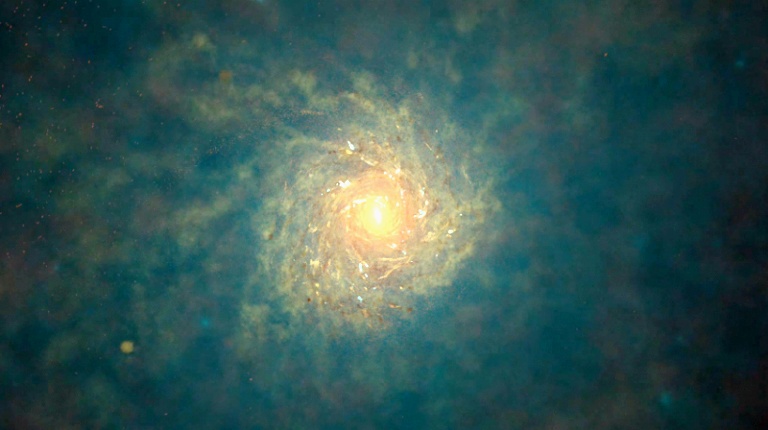पृथ्वी पर कहां से आया सोना और कैसे विशाल बनी हमारी आकाशगंगा
जापान के वैज्ञानिकों ने बेहद दिलचस्प खोज की है। यह खोज न केवल हमारी मिल्की वे अकाशगंगा के अतीत के राज उजागर करती है, वहीं बहुमूल्य सोने की उत्पत्ति पृथ्वी कैसे हुई, इस रहस्य को भी प्रकट करता है। इस दिलचस्प खोज से पता चलता है कि बहुमूल्य धातु सोना सुपरनोवा और न्यूट्रॉन तारों के टकराव से पैदा हुआ। निश्चित तौर पर पृथ्वी पर सोना जमीन के भीतर से निकाला जाता है, लेकिन जमीन के भीतर भी तो कहीं से आया होगा। यह खोज यही बताती है। शोध करने वाले वैज्ञानिक नोट्रे डेम विश्वविद्यालय और तोहोकू विश्वविद्यालय जापान से हैं। यह अनुसंधान रॉयल एस्ट्रोनॉमिकल सोसाइटी के सहकर्मी-समीक्षित वैज्ञानिक पत्रिका मासिक नोटिस में प्रकाशित हुआ है।
सोना सुपरनोवा और न्यूट्रॉन तारों के टकराव में पैदा हुआ
सोना सुपरनोवा व न्यूट्रोन तारों के आपसी टकराव से पैदा हुआ। पृथ्वी के सोने की उत्पत्ति बाह्य अंतरिक्ष में ही हुई है। यह सुपरनोवा (तारों में विस्फोट) और न्यूट्रॉन तारों के टकराव में उत्पन्न होता है। खगोल वैज्ञानिकों ने अत्याधुनिक दूरबीनों का उपयोग कर हमारी मिल्की वे आकाशगंगा में सैकड़ों सोने से समृद्ध सितारों की खोज की है। ऐसे सितारों की उत्पत्ति कम द्रव्यमान वाली बौनी आकाशगंगाओं में हुआ था। एक दूसरी अकशगंगा लगभग 10 अरब साल पहले हमारी मिल्की वे में विलय हो गई थी। पहली बार यह खोज हुई है। जिससे सितारों के गहरे प्राचीन अतीत का पता चलता है। इस तरह के अध्ययन से खगोल के प्रति हमारी समझ भी विकसित होती है।
कई छोटी आकाशगंगाओं के विलय से विशाल बनी हमारी आकाशगंगा
स शोध में वैज्ञानिकों ने जापान की राष्ट्रीय खगोल वैधशाला में संख्यात्मक सिमुलेशन का उत्पादन किया, साथ ही कम्प्यूटेशनल विज्ञान केंद्र में ATERUI II सुपर कंप्यूटर का उपयोग किया। जिससे समय के संबंध में उच्च स्तर के विवरण प्राप्त किए। इस अध्ययन में मिल्की वे का निर्माण व बिग बैंग से वर्तमान तक ट्रैक करता है। इस अध्ययन से आकाशगंगा में सितारों द्वारा गठित सामग्री के चक्र को सटीक रूप से हल करने में सक्षम है। यहां एक खास बात यह है कि हमारी आकाशगंगा पहले इतनी बड़ी नहीं थी, जितनी कि वर्तमान है। इसके विशाल होने की वजह वह छोटी छोटी अकाशगंगाएँ हैं, जो कालांतर में हमारी आकाशगंगा मिल्की वे में विलय हो गई। शोधकर्ता कहते हैं कि सिमुलेशन डेटा से पता चला कि कुछ पूर्वज आकाशगंगाएँ थी, जो 10 अरब साल पहले उनका अलग अस्तित्व था। उन आकाश गंगाओं में बड़े भारी बड़ी मात्रा में मौजूद थे और यह भारी तत्व न्यूट्रॉन तारों के आपसी विलय से आए।
तोहोकू के वैज्ञानिक युताका के अनुसार
तोहोकू विश्वविद्यालय के वैज्ञानिक युताका हिराई कहते हैं कि सोने से समृद्ध तारे आज हमें मिल्की वे का इतिहास बताते हैं। हमने पाया कि 10 अरब साल पहले बौनी आकाशगंगाओं में अधिकांश स्वर्ण-समृद्ध तारे बनते हैं। ये प्राचीन आकाशगंगाएँ मिल्की वे के निर्माण खंड हैं। हमारे निष्कर्षों का मतलब है कि आज हम जो सोना-समृद्ध सितारे देखते हैं, उनमें से कई 10 अरब साल पहले मिल्की वे के बनने के जीवाश्म रिकॉर्ड हैं।
श्रोत : मिल्की वे-जैसी आकाशगंगा के कॉस्मोलॉजिकल ज़ूम-इन सिमुलेशन में अत्यधिक आर-प्रक्रिया-वर्धित सितारों की उत्पत्ति। रॉयल एस्ट्रोनॉमिकल सोसायटी के माध्यम से।
फोटो : रॉयल एस्ट्रोनॉमिकल सोसाइटी
Where did gold come from on earth and how did our galaxy become huge?
Japanese scientists have made a very interesting discovery. This discovery not only reveals the secrets of our Milky Way galaxy’s past, it also reveals the mystery of how the precious gold Earth originated. This intriguing discovery suggests that the precious metal gold may have originated from supernova and neutron star collisions. Of course gold on earth is extracted from underground, but even underground it must have come from somewhere. This is what this discovery suggests. The scientists who conducted the research are from the University of Notre Dame and Tohoku University in Japan. The research is published in the peer-reviewed scientific journal Monthly Notices of the Royal Astronomical Society.
Gold was born in supernova and neutron star collisions
Gold was born from the collision of supernova and neutron stars. Earth’s gold originated in outer space only. It is produced in supernova (exploding stars) and neutron star collisions. Astronomers have discovered hundreds of gold-rich stars in our Milky Way galaxy using state-of-the-art telescopes. Such stars originated in low-mass dwarf galaxies. Another galaxy merged with our Milky Way about 10 billion years ago. This is the first time this has been discovered. Which reveals the deep ancient past of the stars. This kind of study also develops our understanding of astronomy.
Our Milky Way became huge due to the merger of many small galaxies
In this research, scientists produced numerical simulations at the National Astronomical Laboratory of Japan, as well as using the ATERUI II supercomputer at the Center for Computational Science. Due to which high level of details regarding time was obtained. This study tracks the formation of the Milky Way from the Big Bang to the present. This study has been able to accurately resolve the cycles of material formed by stars in the Milky Way. A special thing here is that our galaxy was not as big as it is at present. The reason for its hugeness is those small galaxies, which later merged into our Milky Way galaxy. The researchers say the simulation data showed that there were some progenitor galaxies that had a separate existence 10 billion years ago. In those galaxies, heavy elements were present in large quantities and these heavy elements came from the mutual merger of neutron stars.
According to Tohoku scientist Yutaka
Tohoku University scientist Yutaka Hirai says that gold-rich stars today tell us the history of the Milky Way. We found that most gold-rich stars formed in dwarf galaxies 10 billion years ago. These ancient galaxies are the building blocks of the Milky Way. Our findings mean that many of the gold-rich stars we see today are a fossil record of the Milky Way’s formation more than 10 billion years ago.
Source: Origin of highly R-process-enhanced stars in a cosmological zoom-in simulation of a Milky Way-like galaxy. Via Royal Astronomical Society.
Photo: Royal Astronomical Society

Journalist Space science.
Working with India’s leading news paper.
और अधिक जानें

